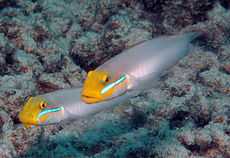Valenciennea strigata
| Valenciennea strigata | |
|---|---|
 | |
| Conservation status | |
| Not evaluated (IUCN 3.1) | |
| Scientific classification | |
| Kingdom: | Animalia |
| Phylum: | Chordata |
| Class: | Actinopterygii |
| Order: | Perciformes |
| Family: | Gobiidae |
| Genus: | Valenciennea |
| Species: | V. strigata |
| Binomial name | |
| Valenciennea strigata (Broussonet, 1782) | |
| Synonyms | |
| |
Valenciennea strigata, the Blueband goby, is a species of goby native to the Indian Ocean and the western Pacific Ocean where it can be found in outer lagoons and the seaward side of reefs It inhabits a variety of substrates, sand, rubble, hard, at depths of from 1 to 25 metres (3.3 to 82.0 ft) (usually at less than 6 metres (20 ft)). This species can reach a length of 18 centimetres (7.1 in) TL. It can also be found in the aquarium trade.[1]
Aquarium Keeping
The Golden-headed Sleeper Goby, Blueband Goby, or Pennant Glider are not only pretty fish, but are great for a marine environment where you want the substrate to constantly be sifted through. These fish really use their mouths! They are constantly digging and turning over the sandy substrate. Besides this ongoing activity of "chewing" the sand, these gobies can communicate with each other by producing signals with their mouths.
Maintenance Difficulty
The Golden-headed Sleeper Goby, Blueband Goby, or Pennant Glider are moderately difficult to keep, considered good for a more experienced aquarist with a larger system, where they can find plenty to eat. Like other members of the Valenciennea species, they feed by taking up mouthfuls of sand and pass it through their gill covers to extract small crustaceans, worms and algae. It is important that they have a sufficient amount of "live" sand for them to sift through.
Maintenance/Foods
A typical goby, they eat small crustaceans and other small marine organisms. Live brine and a high protein krill are ideal for the aquarium. This fish thrives on nearly all marine frozen foods, live and flake foods once feeding.
Social Behaviors
They live in pairs and like to burrow in the sand, especially juveniles.They are peaceful with other fish especially their own kind and may be considered safe to keep in pairs or small groups where space and filtration capacity allows
References
- ↑ Froese, Rainer and Pauly, Daniel, eds. (2013). "Valenciennea strigata" in FishBase. June 2013 version.
| Wikimedia Commons has media related to Valenciennea strigata. |